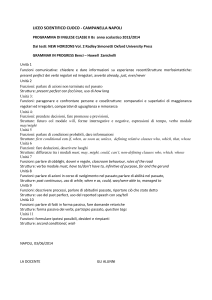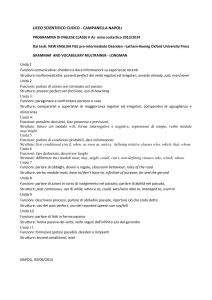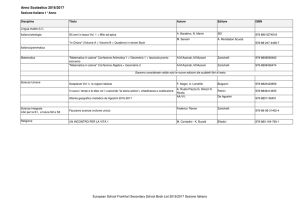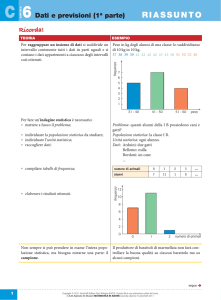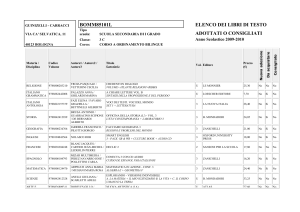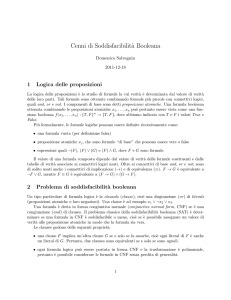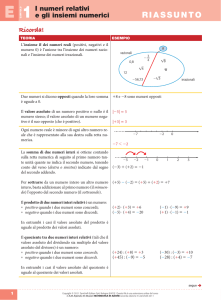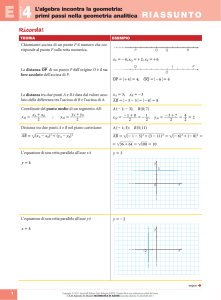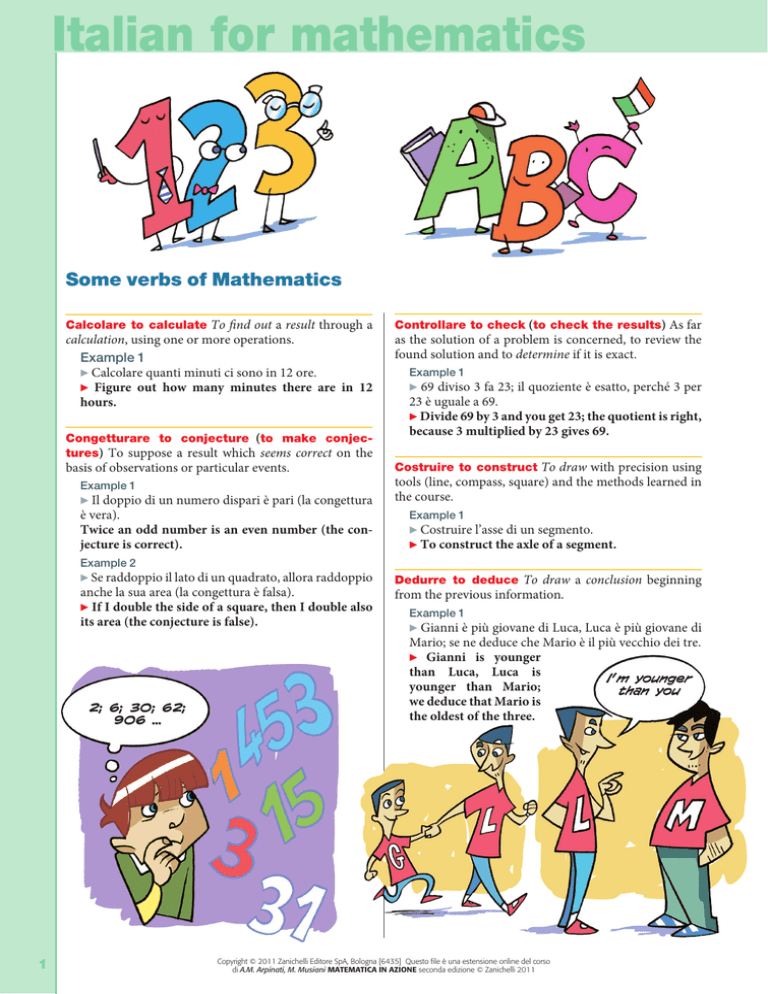
Italian for mathematics
Some verbs of Mathematics
Calcolare to calculate To find out a result through a
calculation, using one or more operations.
Example 1
Calcolare quanti minuti ci sono in 12 ore.
Figure out how many minutes there are in 12
hours.
Congetturare to conjecture (to make conjectures) To suppose a result which seems correct on the
basis of observations or particular events.
Example 1
Il doppio di un numero dispari è pari (la congettura
è vera).
Twice an odd number is an even number (the conjecture is correct).
Controllare to check (to check the results) As far
as the solution of a problem is concerned, to review the
found solution and to determine if it is exact.
Example 1
69 diviso 3 fa 23; il quoziente è esatto, perché 3 per
23 è uguale a 69.
Divide 69 by 3 and you get 23; the quotient is right,
because 3 multiplied by 23 gives 69.
Costruire to construct To draw with precision using
tools (line, compass, square) and the methods learned in
the course.
Example 1
Costruire l’asse di un segmento.
To construct the axle of a segment.
Example 2
Se raddoppio il lato di un quadrato, allora raddoppio
anche la sua area (la congettura è falsa).
If I double the side of a square, then I double also
its area (the conjecture is false).
2; 6; 30; 62;
906 ...
1
Dedurre to deduce To draw a conclusion beginning
from the previous information.
Example 1
Gianni
è più giovane di Luca, Luca è più giovane di
Mario; se ne deduce che Mario è il più vecchio dei tre.
Gianni is younger
than Luca, Luca is
I’m younger
younger than Mario;
than you
we deduce that Mario is
the oldest of the three.
Copyright © 2011 Zanichelli Editore SpA, Bologna [6435] Questo file è una estensione online del corso
di A.M. Arpinati, M. Musiani MATEMATICA IN AZIONE seconda edizione © Zanichelli 2011
Determinare to determine To find a right result, not
necessarily through a calculation.
Example 1
Determinare il numero delle diagonali di un esagono.
Determine the number of the diagonals of a hexagon.
Dimostrare to show To come to the conclusion that a
positive statement is true if based on,
– initial data;
–what has already been learned previously in the progress (definitions and properties);
– what can be deduced by the two previous points.
Example 1
Dimostrare che le diagonali di un parallelogramma
si tagliano l’un l’altra a metà.
Show that the diagonals of a parallelogram cut
themselves in half.
Giustificare to justify To justify has the same meaning
of Showing, but it is used in easier situations.
Ricercare to seek To find information in a book, a
dictionary, in Internet, etc.
Example 1
Example 1
Il doppio di un qualunque numero naturale è un nu-
mero pari; per giustificare questa affermazione, basta
osservare che la metà del doppio è il numero di partenza, dunque ancora un numero naturale.
The double of a whatever natural number is an
even number; in order to justify this statement, it is
enough to observe that half the double gives the initial number, then it’s still a natural number.
Misurare to measure To use a tool to establish the size
Ricercare quando le cifre arabe sono giunte in Europa.
Seek when the Arabic figures arrived in Europe.
struction or a sketch respecting the rules.
Example 1
Riprodurre un quadrato di 3 cm di lato, usando carta centimetrata.
Reproduce a square of 3 cm of side using graph
paper.
Example 1
Misurare
Posizionare to position (to set, to place) To set an
object in a fixed place.
Data una retta r,
posizionare su di
essa un punto P.
Draw a straight
line r, then place
a point P upon it.
Spiegare to explain To explain may have the same
meaning of Justifing, but it can also be related to word.
Example 1
.P
?
Ricercare il significato della parola pentagono.
Look for the meaning of the word pentagon.
Riprodurre to reproduce To draw a figure, a con-
of a quantity.
le dimensioni di un foglio da disegno mediante una riga graduata.
Measure the dimensions of a drawing paper with
a ruler.
Example 2
Example 1
Spiegare che cosa è il perimetro di un rettangolo.
Explain what the perimeter of a rectangle is.
Tracciare to trace To trace may have the same mean-
ing of Constructing, but it is also used for simple sketches.
Example 1
Tracciare una circonferenza con il compasso.
Trace a circumference using the compass.
Verificare to verify To check if a supposition is real
using a measure or an experiment. To test is less powerful than demonstrate, because it concerns particular
cases and it can be spoiled by a mistake in measurement.
Copyright © 2011 Zanichelli Editore SpA, Bologna [6435] Questo file è una estensione online del corso
di A.M. Arpinati, M. Musiani MATEMATICA IN AZIONE seconda edizione © Zanichelli 2011
2
Italian for mathematics
Some prepositions of Mathematics
In the Italian language a lot of prepositions are used. Now
let’s have a look at the most frequently used prepositions
in mathematics and show examples in which they are
employed.
Example 1
Domanda: perché vai
a lezione di pianoforte? Risposta: perché mi
piace la musica.
Question: Why do
you go to the lesson of
piano? Answer: I go
because I like music.
Ma but It often points out a precise statement.
Example 1
Mi piace la matematica, ma ho un po’ di difficoltà.
I like mathematics, but I find it hard.
Example 2
Example 2
Domanda: perché il
triangolo ABC è rettangolo? Risposta: perché
l’angolo in B è retto.
Question: Why
is the triangle ABC
right-angled? Answer: It’s a right-angled triangle
because the angle in B is straight.
25 è un numero, ma non una cifra.
25 is a number but not a figure.
Nè neither It is used
in negative clauses.
Example 1
Non ho la sufficienza né, in Matematica né in Italiano.
I don’t have a pass
mark either in
Mathematics or in
Italian.
School
report
Italian
5
Mathematics 4
History
7
Foreign
language
6
Example 2
Il numero 19 non è divisibile né per 2, né per 3.
Number 19 is not divisible either by 2 or by 3.
E and It connects two affirmations.
Example 1
Ho lezione di musica il martedì e il giovedì.
I have music lesson on Tuesday and Thursday.
Think of English or about the foreign language you are
studying; in English, French and German, it is not like
that: the prepositions used for questions are different
from those used for answers.
Se… allora if… then It is the form with which, starting from a correct affirmation, another affirmation is deduced as correct as well.
Example 1
Se la rappresentazione decimale di un numero naturale termina per 0, allora esso è divisibile per 10.
If the decimal representation of a natural number
finishes for 0, then it is divisible for 10.
Example 2
Se un rombo possiede un angolo retto, allora esso è
un quadrato.
If a rhombus has a straight angle, then it is a
square.
Example 2
15 è multiplo di 3 e di 5.
15 is multiple of 3 and 5.
Dunque = quindi therefore It introduces the conclu-
sion of a discussion.
Example 3
Se sei italiano, allora sei europeo.
If you are Italian, then you are European.
Example 1
Oggi ho lezioni di tennis, dunque prendo la racchetta.
I have tennis lessons today, therefore I take the
racket.
Important note. «If… then» are not always reversible;
we can’t for example affirm: if you are European, then
you are Italian (you could be French, etc.).
Example 2
Oppure or In Italian «oppure» can separate two alterna-
Il triangolo ABC ha due lati della stessa lunghezza,
quindi è isoscele.
The triangle ABC has two sides of the same length,
therefore it is isosceles.
Perché why/because In the Italian language the same
word it’s used both to ask a question and to answer a
question.
3
tive clauses (for example: un numero naturale o è pari o
è dispari, a natural number is or even or odd), but also
two sentences which are between them compatible (for
example: possiamo affermare che un triangolo è equilatero se sappiamo che i suoi tre lati sono uguali, oppure
sappiamo che i suoi tre angoli sono uguali, we can affirm
that a triangle is equilateral if we know that its three sides
are equal, or if we know that its three angles are equal).
Copyright © 2011 Zanichelli Editore SpA, Bologna [6435] Questo file è una estensione online del corso
di A.M. Arpinati, M. Musiani MATEMATICA IN AZIONE seconda edizione © Zanichelli 2011
The clauses of Mathematics
In the Italian language, as in English or French, three
types of clauses can be formulated:
– simple clauses
■ The square has four equal sides. (Il quadrato ha
quattro lati uguali.)
–compound or coordinate clauses
■ The square has four equal sides and the triangle
has three sides. (Il quadrato ha quattro lati uguali e
il triangolo ne ha tre.)
–complex or subordinate clauses
■ If a triangle has an angle of 90°, then it is a rightangled triangle. (Se un triangolo ha un angolo di
90°, allora è un triangolo rettangolo.)
Simple clauses can have these functions:
–to give an information – frase enunciativa
■ The square has four equal sides. (Il quadrato ha
quattro lati uguali.)
–to ask a question – frase interrogativa
■ How many sides has a pentagon? (Quanti lati ha un
pentagono?)
–to command – frase imperativa
■ Draw the bisecting line of the angle! (Traccia la bisettrice dell’angolo!)
Joining two simple clauses with a conjunction you get
compound clauses. As:
–copulative clauses
■ Number 15 is multiple of 3 and it is also multiple
of 5 (Il numero 15 è multiplo di 3 e è multiplo anche
di 5.) where both clauses are real.
–strong disjunctive clauses
■ The natural number 3 is even or odd (Il numero
naturale 3 è pari o è dispari.) where only one clause
is real;
–weak disjunctive clauses
■ We can assert that the square is equilateral or equiangular. (Si può affermare che il quadrato è equilatero oppure equiangolo.)
–adversative clauses
■ 25 is a number, but not a figure (25 è un numero,
ma non è una cifra.), where the second clause limits
and partly contradicts what is said before;
–explicative clauses
■ 4 by 3 gives 12, that is 4 + 4 + 4 (4 3 fa 12, cioè 4 +
4 + 4 .), where the second clause clarifies the meaning
of the first clause;
–conclusive clauses
■ The triangle ABC has two sides of the same length,
therefore it is isosceles (Il triangolo ABC ha due lati
della stessa lunghezza, dunque è isoscele.), where the
second clause expresses a consequence of the first
clause;
–correlative clauses
■ Number 19 is neither divisible by 2, nor by 3 (Il
numero 19 non è divisibile per 2, né è divisibile per
3.), where both clauses are real.
Joining strongly one clause to another you can get complex clauses, for example:
–causal clauses
■ The triangle ABC is right-angled, because the
angle in B is right. (Il triangolo ABC è rettangolo,
perché l’angolo in B è retto.), where the clause introduced from «because» (perchè) explains the reason
why it is true what it’s said in the first clause;
–conditional clauses
■ If a rhombus has a right angle, then it is a square.
(Se un rombo possiede un angolo retto, allora è un
quadrato.), where the first clause shows the condition why the second is true;
–relative clauses
■ A quadrilateral, whose sides are equal two by two,
is a parallelogram (Un quadrilatero, i cui lati sono
uguali a due a due, è un parallelogramma.), where one
of the clauses is introduced by a relative pronoun.
There are also other kinds of complex clauses commonly
used in mathematics, which however are not difficult to
be understood.
Copyright © 2011 Zanichelli Editore SpA, Bologna [6435] Questo file è una estensione online del corso
di A.M. Arpinati, M. Musiani MATEMATICA IN AZIONE seconda edizione © Zanichelli 2011
4


